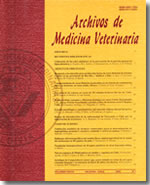Comparative study of nested PCR, ELISA and AGID tests in the detection of bovine leukaemia virus infection in serum, blood and milk samples
Main Article Content
Abstract
Different methods available for the detection of bovine leukaemia virus (BLV) infection were evaluated. The methods evaluated were AGID in serum, ELISA in serum and milk, and PCR in blood lymphocytes. The AGID test identified a smaller number of positive animals (75/126) compared to PCR and ELISA tests (100/126). Three positive animals by AGID were negative by PCR and 28 of the 51 negative samples by AGID were positive by PCR. The sensitivity of PCR with respect to AGID was 96%, whereas the specificity was 45% (kappa 0.45). All positive animals by AGID were also positive by ELISA in serum and milk samples, whereas 25 negative animals by AGID were considered positive by the ELISA test, in both biological samples. Thus, sensitivity of the ELISA with respect to AGID was 100%, whereas specificity was 51% (kappa 0.55). The smaller sensitivity of AGID is not due to false positive reactions of ELISA and PCR tests, but rather to a greater sensitivity of these, which suggests a revision of AGID in those countries in which it is still used as the official method in the erradication programs of leukaemia.

